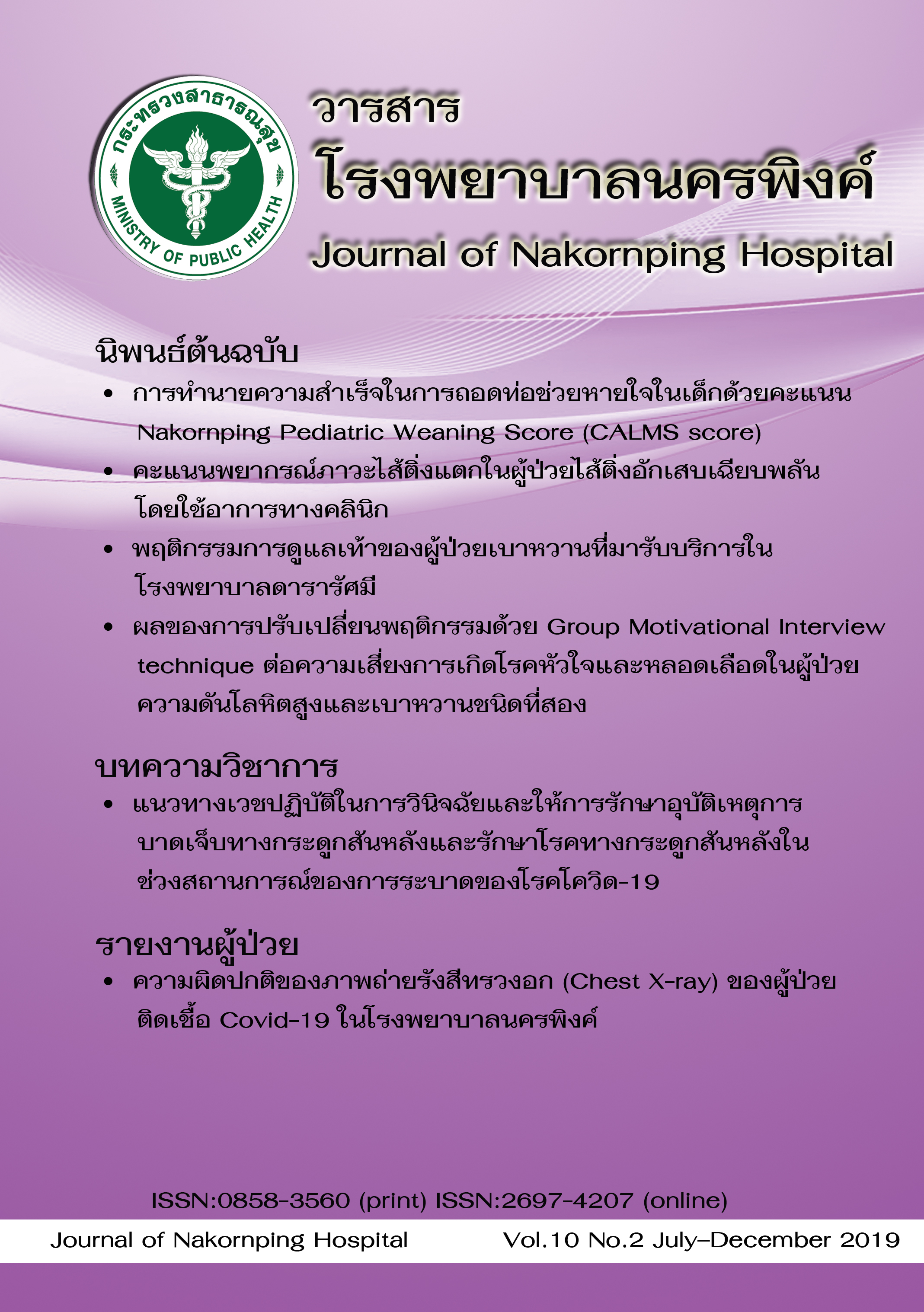Nakornping Pediatric Weaning Score (CALMS Score) prediction of extubation success in children
Keywords:
Extubation readiness test, Extubation, Weaning, CALMS scoreAbstract
Taking out the endotracheal tube is a very important step for patients. Nakornping Hospital has developed the CALMS score for assessing the readiness of patients before removing the endotracheal tube. This research is aimed to assess the sensitivity and specificity of CALMS score and cut of point to guide for extubation success in children.
Method A prospective cohort study was conducted and included all patients, aged 1 month to 15 years, who were intubated in the pediatric intensive care unit between October 2017-September 2018. Demographic data, intubation data, CALMS score and extubation result were recorded and presented in sensitivity, specificity and cut-off point to predict an extubation success.
Result Two hundred and four patients were enrolled. One hundred and four were male (60.8%), 90 children (44.1%) had age less than 1 year and 94 children (46.1%) had age 1- less than 7 years. Overall extubation success rate was 91.7%. Extubation success rate in patients who performed and did not perform CALMS score was similar (89.1% and 96.0%, P-value = 0.238). Within the performed CALMS score group, the successful extubation patients had significantly higher CALMS score than the failed extubation paitents (mean score 9.17 ± 0.81, and 8.43 ± 1.40, P-value <0.001). At cut off point =9 (out of 10), the score had sensitivity 85.22 specificity 42.86 and
Receiver Operating Characteristic (AUROC) was 0.66 (95%CI 0.50-0.83).
Conclusion CALMS score can be used to predict the success of extubation in infants and children. The score at 9 points or more has better sensitivity, however appropriate CALMS to maximized extubation success may need further studies.
References
Rothaar RC, Epstein SK. Extubation failure: magnitude of the problem, impact on outcomes, and prevention. Curr Opin Crit Care. 2003 Feb;9(1):59-66.
Newth CJ, Venkataraman S, Willson DF, Meert KL, Harrison R, Dean JM, et al. Weaning and extubation readiness in pediatric patients. Pediatr Crit Care Med. 2009 Jan;10(1):1-11.
Thille AW, Richard JC, Brochard L. The decision to extubate in the intensive care unit. Am J Respir Crit Care Med. 2013 Jun 15;187(12):1294-302.
Kurachek SC, Newth CJ, Quasney MW, Rice T, Sachdeva RC, Patel NR, et al. Extubation failure in pediatric intensive care: a multiple-center study of risk factors and outcomes. Crit Care Med. 2003 Nov;31(11):2657-64.
Esteban A, Alía I, Gordo F, Fernández R, Solsona JF, Vallverdú I, et al. Extubation outcome after spontaneous breathing trials with T-tube or pressure support ventilation. The Spanish Lung Failure Collaborative Group. Am J Respir Crit Care Med. 1997 Aug;156(2 Pt 1):459-65.
Chavez A, dela Cruz R, Zaritsky A. Spontaneous breathing trial predicts successful extubation in infants and children. Pediatr Crit Care Med. 2006 Jul;7(4):324-8.
Khemani RG, Hotz J, Morzov R, Flink RC, Kamerkar A, LaFortune M, et al. Pediatric extubation readiness tests should not use pressure support. Intensive Care Med. 2016 Aug;42(8):1214-22.
Karthika M, Al Enezi FA, Pillai LV, Arabi YM. Rapid shallow breathing index. Ann Thorac Med. 2016 Jul-Sep;11(3):167-76.
Hess DR, Kacmarek RM. Weaning from mechanical ventilation. Essentials of mechanical ventilation, 2nd ed. New York: McGraw-Hill; 2002.121-35.
Mhanna MJ, Anderson IM, Iyer NP, Baumann A. The use of extubation readiness parameters: a survey of pediatric critical care physicians. Respir Care. 2014 Mar;59(3):334-9.
Cavallone LF, Vannucci A. Review article: Extubation of the difficult airway and extubation failure. Anesth Analg. 2013 Feb;116(2):368-83.
Wood L. Pathophysiology and differential diagnosis of acute respiratory failure. Principle of critical care, 3rd ed. New York: McGraw-Hill;2005.417-26.
de Caen AR, Berg MD, Chameides L, Gooden CK, Hickey RW, Scott HF, et al. Part 12: Pediatric Advanced Life Support: 2015 American Heart Association Guidelines Update for Cardiopulmonary Resuscitation and Emergency Cardiovascular Care. Circulation. 2015;132(18 Suppl 2):S526-42.
Kundra P, Krishnan H. Airway management in children. Indian J Anaesth. 2005; 49(4):300-307.
Baisch SD, Wheeler WB, Kurachek SC, Cornfield DN. Extubation failure in pediatric intensive care incidence and outcomes. Pediatr Crit Care Med. 2005 May;6(3):312-8.
Downloads
Published
How to Cite
Issue
Section
License
The articles that had been published in the journal is copyright of Journal of Nakornping hospital, Chiang Mai.
Contents and comments in the articles in Journal of Nakornping hospital are at owner’s responsibilities that editor team may not totally agree with.



